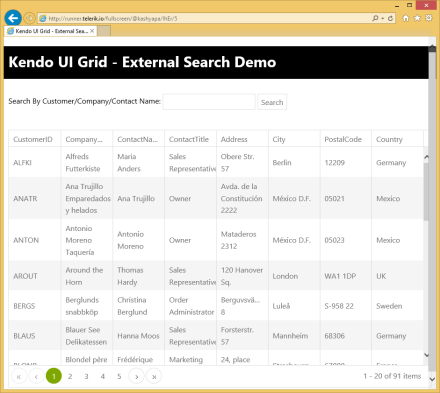On Mar 12 2015 we conducted yet another webinar as part of our monthly webinar series. This time we were happy to invite Vidyasagar Machupalli who is a Microsoft MVP in Gaming. In fact he is the only Gaming MVP in South East Asia. The topic for this webinar was “Integrating SignalR in HTML5 Applications with Kendo UI”. Idea was to talk about real time communication in ASp.NET using SignalR and how Kendo UI makes it easy to work with SignalR.
ASP.NET SignalR:
Here is what the official description of SignalR is at http://www.asp.net:
ASP.NET SignalR is a new library for ASP.NET developers that makes developing real-time web functionality easy. SignalR allows bi-directional communication between server and client. Servers can now push content to connected clients instantly as it becomes available. SignalR supports Web Sockets, and falls back to other compatible techniques for older browsers. SignalR includes APIs for connection management (for instance, connect and disconnect events), grouping connections, and authorization.
Kendo UI:
If you have been attending our webinars, you would have known about Kendo UI by now. If not, Kendo UI is a single package you need to develop HTML5 based sites/apps. Kendo UI is a HTML5 based client side JavaScript UI framework. To know more about Kendo UI head over to the project page here: http://www.telerik.com/kendo-ui. You can find Kendo UI demos online here: http://demos.telerik.com/kendo-ui
Slides:
Video:
Questions:
Q: Hi, SignalR is an advanced topic related to Web Sockets or Server Sent Events etc. Or it rely on these architecture?
A: SignalR is a real time communication technology on ASP.NET Stack from Microsoft.
Q: In order for the server to do real-time communication with SignalR, should the server be an IIS web server ?
A: SignalR at the moment can be hosted in IIS or as a stand alone process. But this requires you to be on Windows platform.
Q: Can we use Telerik controls with SignalR?
A: Absoutely. Telerik Kendo UI has specific binding/ support for SignalR.
Q: SignalR is purely async based or can it be set to be in sync mode like the way node.js is an async by default but can be set to mode sync?
A: SignalR is a server side technology and all it does is to keep track of all the clients connected and intimate them of any updates. So typically server sends a broadcast to all connected client and clients know how to react to this update on the client side.
Q: What is the most important advantage of SignalR ?
A: Real Time Communication between Server & Client.
T-Shirt Winners:
As usual we have picked 2 attendees randomly to receive our T-Shirts. They are:
- Sonam Bhardwaj
- Kapil Chhabra
Congratulations to the winners. We will contact you shortly on your registered email id. Rest of you, do keep attending our future webinars.
Till next time – Happy Coding.









